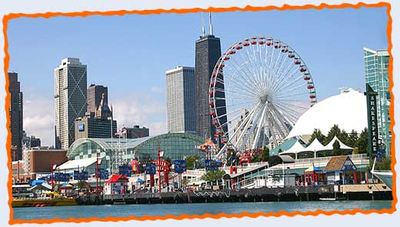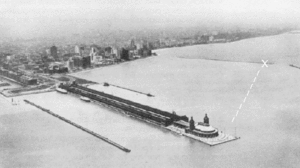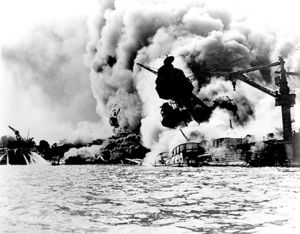Navy Pier
Navy Pier is a pseudo-historical tourist trap in downtown Chicago, Illinois, USA. Located where Lake Shore Drive meets Lake Michigan, the pier is well known as the site of a Ferris wheel, an 11-story roller coaster, a Shakespearean theater, the Trump Tower, the John Hancock Center, an 80,000 resident low-income housing project, City Hall, and the Lincoln Park Zoo. Boats also dock there. Navy Pier has not had any relation to the U.S. Navy since the infamous attack on the pier by the Japanese Air Force in 1941, which destroyed the entire U.S. Great Lakes Fleet and brought America into the Second World War.
Early Years[edit | edit source]
Up until the mid 1700's, the Chicago area was a swamp inhabited by primitive trolls. The Chicago river at the time flowed from Lake Michigan into what would become the downtown area, making any kind of permanent settlement difficult. This changed when Louis Joliet arrived with a squadron of French soldiers, claiming the region in the name of France and forcing the trolls to reverse the flow of the river through a series of canal projects. In the process, they built the first Navy Pier. By 1782, French vessels were bringing cloth and venereal disease to the natives, along with civilization.
The Early American Era[edit | edit source]
After the end of the War of Colonial Aggression in the late 1700's, the new Federal Government of the United States bought from France much of the land west of the Appalachian mountains, via the famed Louisiana Purchase. Chicago, Illinois thus fell into American hands. American settlers and pioneers were quick to see the value in smelly swamp land. They set up an outpost called, "Fort Dearborne," and made the pier the centerpiece of their settlement. Now, instead of trading cloth and venereal disease, they traded guns, pox blankets, and fire water with the local Native Americans. Also, as some point in time and for reasons that remain unknown to this day, the settlers renamed the outpost, "Chicago."
[edit | edit source]
In the 1870's, a huge fire destroyed virtually all of Chicago (see, the Great Chicago Fire). Navy Pier, being made of bamboo and straw, was one of the first structures to burn down in the conflagration. The city was left without a pier for decades, until in 1903 the Aldermen of the city commissioned a reconstruction project. This time, the pier would be built of the hardest material on earth - pure diamonds. Navy Pier was thus resurrected from the ashes like a Phoenix, and became the focal point of the United States Navy.
[edit | edit source]
On December 7, 1941, a date which shall live in infamy, the Imperial Air Force of Japan conducted a surprise raid on Navy Pier, destroying the entire American Great Lakes Fleet. Forty-three aircraft carriers, 200 battleships, and 3 cruisers were obliterated. U.S. President Franklin D. Roosevelt addressed the nation in a recorded hate-speech, saying that America, "would bomb those Japs back into the Stone Age." America entered the pending Second World War immediately, and by 1945 had invented the atomic bomb and had devastated Nagasaki and Hiroshima (two towns in Japan) with the power of the atom. Not even Godzilla was strong enough to stop the might of the Americans.
[edit | edit source]
After WWII, the Americans did not bother to rebuild Navy Pier until the 1990's, at which point someone in Chicago decided it would be a good idea to put, basically, the whole city there. Now, instead of military vessels, tourists can see yachts, sky-scrapers, amusement park rides, city government buildings, museums, and housing projects all at Navy Pier.


